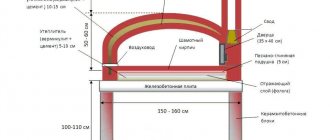Manufacturing
To be sure, you should look for drawings for assembling the stove yourself. Next you need to prepare the tool. To make a stove we will need:
- a welding machine and a set of electrodes depending on the thickness of the metal used;
- drill with a set of metal drills;
- grinder and several grinding and cutting discs;
- various small tools (hammer, chisel, tape measure, etc.).
The quantity and composition of the necessary materials for assembling the slobozhanka depends on the chosen air supply design and drawing.
Slobozhanka is an excellent choice for heating a small room. Cost-effectiveness, omnivorousness, reliability, low cost, simplicity of design—these are precisely the qualities that have always distinguished “our product” from products assembled abroad.
Performance characteristics
The Slobozhanka stove has the following characteristics:
- Long-term combustion, and therefore the heat supply, is ensured for six to twelve hours, everything directly depends on the type of solid fuel used. For example, well-compacted sawdust smolders for up to twelve hours, and needles or cones for about six hours;
- The efficiency is about 90%, which ensures the production of thermal energy up to 16.00 kW/hour;
- The furnace operates on various solid types of energy carriers of plant origin, and some models operate on waste oil;
- Heating time at full load is about 12 hours;
- Various combustion chamber volumes. If you use a metal barrel for the body, then 200 liters. That is, you can choose the volume of the combustion chamber that best suits the conditions for heating rooms with different functional purposes and area;
- High degree of fire safety due to the absence of open flame and soft combustion, smoldering of fuel. This allows the use of heating devices of this type in greenhouses (plants can grow half a meter from the stove).
Making a furnace
First, the body for the Slobozhanka long-burning stove is assembled. The top of an empty gas cylinder or metal barrel is cut off, leaving a cylinder with a bottom. You can make a part from a steel sheet by connecting its sides. The structure is welded and connected to the bottom. The size of the housing depends on the dimensions of the oven itself. A round hole with a diameter of more than ten centimeters is cut out in the upper part of the sidewall for mounting the pipe. It must be carefully welded to the body. The second hole is cut in the center of the bottom. Its diameter must correspond to the dimensions of the pipe.
You can make such a stove yourself
After this, an air supply system to the fuel is designed. The thick-walled pipe is cut according to the height of the firebox. Grooves are made in its walls for free air movement. A round element is made from a steel sheet according to the diameter of the pipe. It is attached to the bottom of the air duct so that the hole on it can be closed and opened freely. This part will regulate the supply of oxygen to the part of the device where the firebox will be.
A steel sheet will also be needed to cut out a round part to fit the diameter of the main cylinder. You need to make a hole in the center of this sheet and insert the prepared pipe into it. Its ends should protrude outward by 25-30 centimeters.
How to make a Slobozhanka stove with a water circuit:
An inner pipe is placed in the outer structure. Holes are cut in the outer casing. Separately, two round parts are prepared from a steel rod. Their heads are sharpened. The distance between the inner and outer casings is equal to the length of the cylinders. Elements made of rods are inserted into the holes on the walls of the furnace and their heads are riveted with a hammer. All that remains is to make the lid. You need to cut a circle from a steel sheet with a diameter equal to the outer casing. The part must be welded to the top of the furnace.
The operating principle of the Slobozhanka stove is based on the upward movement of cold air flows, so it is raised above the floor by 20-30 cm. Four strong legs made of reinforcing rod are welded to the bottom of the structure. They also use a corner of such a width that there is room for oxygen circulation. It is better to make the chimney from fire-resistant sheet metal
The diameter of the part is at least 10 cm, this is important for air movement
Slobozhanka stove on sawdust:
When working with a welding machine and grinder, you must follow safety precautions, protecting your hands and face from sparks. The finished stove is used immediately after its manufacture.
Materials for making a long-burning stove
Long-burning stoves can be made by hand from sheet metal or various metal structures. Examples and drawings of such stoves are given below.
Barrel stove
A home-made heating device intended for heating utility rooms, made from a two-hundred-liter metal barrel. The stove runs on sawdust, shavings and other woodworking waste. Inside the large barrel, a small barrel for loading fuel is installed on a stand. Underneath is an ash pan - a drawer made of sheet metal.
The stove itself is placed on a stand, the role of which is played by a car disk. A smoke pipe is made from pipe scraps with a diameter of 100-150 mm. The barrel is equipped with a sheet metal lid with a handle and an opening for air supply.
A log sharpened to a cone is installed inside a small barrel; it is indicated in the drawing. Sawdust is poured around it. After compaction, the log is removed and the sawdust is set on fire. During the smoldering process, gas is released into the space of a large barrel, where it is burned.
Furnace with water circuit made of metal pipe
A homemade long-burning stove made of a metal pipe, which can burn wood or sawdust, is equipped with a water circuit. Loading is done from below; to intensify combustion, an air distributor is installed inside the stove, pressing the smoldering wood.
A telescopic hollow pipe is installed in the center of the disk, through which air flows directly into the combustion chamber, where, thanks to the ribs welded onto the disk, it is evenly distributed over the entire surface of the firewood. It lowers on its own as the fuel burns out. You can lift it before loading using a cable.
The loading door is located in the center of the oven. At the bottom there is a cleaning door and an ash pan. At the top there is a chimney. The stove is equipped with a water circuit with pipes for water inlet and outlet. Such a stove with a water circuit can heat small houses and other premises quite efficiently, and you can make it with your own hands from scrap materials.
Furnace from a waste gas cylinder
A stove can be made from a gas cylinder without extra costs or searching for suitable material. The dimensions of the 50-liter cylinder are perfect for making such a stove, and the wall thickness and tightness make it safe to use.
The design of the furnace as a whole does not differ from the previous model, this can be seen in the drawing. A propane tank with a cut off top is used as a body. You can make a lid of a suitable size from sheet metal with your own hands, with a hole for the air distributor pipe. Fuel is loaded through the top, filling the volume of the cylinder almost to the chimney. This stove operates on sawdust and other waste, as well as small firewood. The fuel is carefully compacted, ignited using wood chips or an ignition agent, an air distributor is installed, and then covered with a lid.
The efficiency of such a stove is quite high, and thanks to its sealed housing, it can be used to heat rooms where people stay for a long time. If desired, it can be equipped with a water circuit by passing the chimney through the boiler.
How and with what to drown Bubafonya
The beauty of this design is that it is easy to adapt to any fuel. In this “pristine” form, it is more suitable for firewood. But firewood can also be sprinkled with some kind of waste: wood chips, sawdust, sunflower or buckwheat husks, etc. The more fuel is compacted in the boiler, the longer the stove will burn, but at the same time, the level of combustible materials must be lower than the exit of the chimney opening.
If you are going to heat Bubafonya exclusively with sawdust, the thickness of the walls of the stove should be larger (at least 10 mm), as well as the size of the boiler - the density of sawdust is low, just like a rammer. There is no need to introduce any other design features. Unless you come up with a device for supplying fuel inside the firebox. Sawdust is not firewood, it can crumble.
To ensure that sawdust burns normally, before filling it into Bubafonya, insert a pipe or a shovel holder, pour sawdust around the pipe, and compact it. When all the fuel is in, remove the pipe. Now you can fire up and install the piston.
You can make the Bubafonya furnace work during mining. In order not to redo the structure, you place several broken refractory bricks and several whole standing ones on the bottom (the piston rests on them), and a “fuel line” is passed through the air supply pipe. You can use a pipe of smaller diameter for this purpose. Light a fire between the broken bricks and place a piston and lid on top of the whole ones.
Tools
41 votes
+
Vote for!
—
Vote against!
An excellent option for heating a greenhouse would be to make a stove that can maintain the optimal temperature for comfortable plant growth. Let's look at how to build a stove for a greenhouse with your own hands below.
Table of contents:
- General concept and design of a stove for a greenhouse
- Types of long-burning stoves for greenhouses
- Manufacturing a stove for a long-burning greenhouse
- Making a brick oven for a greenhouse
- Stove for a greenhouse made of two metal barrels
- Do-it-yourself waste oil stove
- Construction of a standard stove for a greenhouse
General concept and design of a stove for a greenhouse
The process of heating a greenhouse is quite complex, since plants require constant, uniform heat. There are several options for heating a greenhouse installation:
- biological,
- electric,
- air,
- gas,
- stove
Let's consider the last option. Heating a greenhouse with a stove is quite economical and allows you to use a wide variety of fuels. Stoves for heating greenhouses can operate on gas, wood, coal, pellets, etc. The main disadvantage of stove heating is the rapid heating of the stove, which leads to dry air. Therefore, in the process of heating the greenhouse, it is recommended to use a Burelyan stove. Its walls are not subject to heating, and it is also reliable and easy to use.
Types of long-burning stoves for greenhouses
1. It is possible to use the Burelyan stove as heating equipment for a greenhouse. This device is convector, it practically does not heat up and runs on wood.
The operating principle is:
- thermal radiation,
- heat transfer,
- convection.
The appearance of the stove resembles a barrel that contains a two-tier firebox. There are pipes around it, in a curved form, the heating power depends on their number.
The Burelyan stove also includes:
- door through which fuel is loaded,
- smoke damper,
- traction control device.
During the process of loading fuel, it gradually smolders, and the gas that is produced during this process circulates through the pipes and heats the room.
2. Another device that is also used in the process of heating a greenhouse is the Butakov stove, which is practically no different from the Burelyan stove in terms of its operating principle. It’s just that it has a body in the form of a parallelepiped, which houses the fuel system and pipes through which air circulates. The Butakov stove also includes the presence of:
- flaps,
- chimney,
- ash pit, which the Burelyan stove does not have.
3. Another option for a long-burning stove is the Bubafonya stove. This device is quite easy to build yourself, unlike previous options. The Bufafonya stove consists of a body part, which is used as a barrel or a gas cylinder. On the body part there is a door into which fuel is placed. The lower part is equipped with an ash pan. The smoldering process occurs due to the presence of constant pressure, which is carried out due to the weight of the metal structure.
4. The Slobozhanka stove or super potbelly stove is the best option for heating a greenhouse. It includes:
- combustion chamber,
- convection shirt,
- two channels for oxygen supply and distribution,
- additional components, their quantity depends on individual conditions and heating characteristics.
The Slobozhanka stove is distinguished by the presence of an upper ignition chamber, as well as an oxygen supply, which is carried out in the lower part.
There are several types of combustion:
- upper side,
- top center.
Slobozhanka stoves differ in operating principle:
- a device with an L-shaped pipe that supplies air to the firebox;
- device with central air supply;
- device with lower side air supply.
This stove can operate both on regular wood and on other alternative fuels, such as pellets, cones, etc.
Manufacturing a stove for a long-burning greenhouse
A long-burning stove installed in a greenhouse allows minimizing human intervention in the heating process. Its operating principle is based on the smoldering process of fuel, so once you load the fuel into the stove, you can leave it for a while. During smoldering, the fuel burns gradually and releases much more heat than during combustion.
Conventional furnace systems do not provide the ability to ensure long combustion, since they have free access to oxygen and a gas exhaust system. Active smoke draft promotes the combustion process. Therefore, the burning rate depends on the thrust force. The long-burning furnace is distinguished by its long combustion duration and high heat output coefficient. If its structure is completely filled with fuel, it will operate without human intervention for more than ten hours.
Air enters the long-burning furnace in portions; its supply is controlled by a power regulation mechanism. When the wood is completely burned in the top part of the stove, a special hole through which oxygen enters is blocked. Due to the fact that there is practically no air in the furnace, the draft weakens.
During the smoldering process, a lot of flue gas is released, which is located above the firebox in the afterburning chamber. This gas promotes the release of heat. The design of the long-burning stove helps to use fuel as efficiently as possible.
To ensure maximum performance, such a stove must be filled almost completely with fuel.
For heating it is possible to use:
- charcoal,
- brown coal,
- peat briquettes.
The use of anthracite coal is prohibited due to possible burnout of the stove body.
The main advantages of a long-burning stove are:
- long service life,
- no need for constant intervention in the work process,
- high heat transfer with low fuel consumption.
Let's consider the option of heating a greenhouse with wood using a self-made prop stove.
Its construction requires the presence of:
- metal barrel 200 l,
- metal channel,
- steel pipes.
1. The upper part of the barrel should be broken off, and the resulting sharp edges should be smoothed out.
2. Next, cut out a place for the pipe in the lid of the barrel and attach a channel to it.
3. A piece of pipe is welded to the top of the barrel, which will serve as a smoke exhaust.
4. The central part of the lid should be connected to another pipe of a smaller diameter, which will act as a device through which air flows.
5. The next stage is making a lid for the barrel. The lid must have a hole for the pipe to enter.
6. Connect the stove with the lid and chimney.
7. Check the device for functionality. To do this, fill the third part of the stove with firewood, install a pipe for air intake and light the stove.
8. The standard cycle of such combustion is about 8 hours. If the barrel is completely filled with firewood, it can work without human intervention for about three days.
Making a brick oven for a greenhouse
To ensure reliable heating of the greenhouse using firewood, you need to build a brick stove with a hog, which, due to the presence of maximum lift, will provide excellent traction.
Materials for making a brick oven:
- several metal pipes,
- two steel plates, it is possible to use plates from under an old stove,
- about 450 bricks.
The construction of a furnace begins with the construction of a foundation; it is advisable to make it monolithic. To make it, use cement mortar.
When constructing a firebox, install two steel pipes in its upper part through which air will circulate.
In a place above the combustion part of the stove, place a tank that will contain water. Having a tank will help avoid dry air. Start laying bricks around the entire perimeter of the stove. To do this, use cement or clay mortar.
Make a hole through which the channels will be cleared of ash.
Stove for a greenhouse made of two metal barrels
Materials for work:
- two metal barrels of 200 l;
- steel pipe, 1.6 s;
- small pieces of reinforcement or steel strips.
This oven looks like an ordinary container that is closed with a lid. Inside it is divided by a metal partition, the lower part is installed on the floor, it has a door and legs, and the upper part is connected to the chimney.
It is possible to use only one barrel, but in this case you will have to work longer.
Instructions for making a stove for a greenhouse:
1. Cut out the top of the first barrel and install the chimney pipe into it.
2. Cut a hole in the bottom with a diameter of 10 cm.
3. Take the second barrel and cut it into two equal parts, one of which will be 25 cm.
4. This part should be machined to install the door and the hole into which the fuel will be placed.
5. Using reinforcement or steel strips, make and weld the legs.
6. Using a welding machine, connect the stove to the chimney pipe and the firebox. Watch the connection, the seams must be of high quality.
7. Make a lid from the material left over from the second barrel.
8. Connect the oven and check its operation.
To charge the stove, you need to make a special tool. It should have the shape of a cone, with a top of 15 cm. This tool is installed in the stove before adding fuel. This stove burns sawdust, so it should be carefully placed in the firebox. Do not fill the oven completely, just fill a third of it.
Once the fuel is in the stove, the cone should be removed. The hole that was formed as a result of placing a cone in the stove needs to be filled with wood chips and lit. After the sawdust ignites, close the stove lid. This stove is capable of heating a greenhouse for more than two days and does not require human intervention in the heating process.
To protect the greenhouse from fire, it is possible to manufacture an additional element near the stove lid, this will be the so-called shutter, into which ordinary sand is poured. Thus, even with strong burning, sand will ensure fire safety.
If there is no second barrel, it is possible to make the stove from only one barrel. In this case, the device for a separate firebox and firewood supply will be located in one barrel. This will lead to some inconvenience, but will not affect the quality of work.
Do-it-yourself waste oil stove
If there is a service station nearby, then an excellent option would be to make a stove that will heat the greenhouse using used automobile oil.
This furnace is characterized by the presence of:
- chimney,
- holes through which oil is poured,
- damper - combustion regulator,
- containers for oil.
This stove is also used for heating water or cooking food, since its upper part gets very hot.
To make it, use the diagram:
Use a pipe as a chimney, which should be positioned strictly vertically.
The operating principle of such a furnace is:
- pouring 2.5-3 liters of used oil into a container;
- setting fire to a filter, which is made of paper and installed in the opening of the stove;
- covering the hole with a flap so that the hole is 1-2 cm;
- after the fuel ignites, the damper regulates its combustion level;
- within five minutes the oven will begin standard operation and heating;
- The stove is adjusted by adding oil and adjusting the damper position.
It is possible to connect such a stove to a water heating circuit. Its power allows you to do this.
Construction of a standard stove for a greenhouse
The main components of this design are:
- fuel compartment,
- bottom,
- blower,
- chimney,
- lid,
- fuel supply device.
It is possible to use wood chips, small firewood or sawdust as fuel. The amount of fuel should be three times less than the stove capacity.
To make such a furnace, you must perform a number of steps:
1. Take a piece of steel pipe, the diameter of which is 400 mm, it will serve as a fuel tank. another piece, 100 mm in diameter, will be the chimney.
2. Next, prepare a piece of tin sheet at least 0.5 cm thick.
3. The process of making a fuel tank involves cutting a hole at the top of the pipe, the diameter of which is equal to the diameter of the chimney. Making the bottom of the oven. To do this, using a grinder, cut a hole in the bottom of the stove with the same diameter as the firebox. This process includes marking and preliminary measurements of the firebox.
4. Cut longitudinal lines in the pipe, up to 1 cm in diameter, the number of lines is about fifty. Weld the pipe to the bottom of the oven.
5. Using sheet steel, start making the lid. It should fit very tightly on the pipe. The lid must have an opening for oxygen supply.
6. To install the chimney, you should connect the pipe to the pipe using a clamp, and then weld the pipe to the stove.
7. Place the chimney pipe onto the pipe and ensure the seams are sealed.
8. Install the oven on a support element made of a steel profile. Please note that the stove gets very hot, so you should not place it close to plants.
Slobozhanka stove review
It is worth noting that the Slobozhanka stove is the subject of a separate article, so this is exactly what we are talking about. This is a long-burning convection oven, which has several models with different parameters and purposes.
Slobozhanka stoves are designed for people with average incomes who need an effective and inexpensive heat source. They work on almost any fuel, but it must be of plant origin. For example, pine needles, cones, straw, sawdust. That is why this type of stove is very popular for those who heat household facilities.
Slobozhanka stove: characteristics
It is worth noting that the Slobozhanka stove has a simple design. Therefore, making it with your own hands will not be difficult for a person who knows how to work with a welding machine. The various models differ from each other only in the air supply system. And this does not depend on the ignition units and their presence, additional loading, the size of the combustion chamber and other elements.
In all models, air is supplied to the very bottom of the firebox, then it rises to the fuel combustion zone. The main difference is only in the channel design of the air distribution unit. With all this, air delivery and the design of the supply unit in the furnace determine the forms of upper combustion of the incoming fuel. The forms are as follows:
1. Slobozhanka stoves have top-side combustion, that is, the fuel burns from the top to the bottom of the firebox, but in the coal from the chimney.
2. Top-center combustion. This means that the fuel burns away from the fuel chamber, from the center to the very bottom.
Based on this, there are three main models of stoves that are used in everyday life:
The first type has a side air supply from the downward side of the firebox. This model has a pipe in the shape of the letter “L”, from where the air is distributed through the channel of the perforated screen into the combustion zone.
The second type has a central lower air supply, which is distributed from bottom to top. The center channel is located in the very center of the combustion chamber.
The third type of model has a lower side feed, which is distributed from the sides and then goes up the channel into the fuel combustion zone.
Typically the combustion process lasts about 8 hours. It is clear that firewood will smolder the longest and release energy. But straw or pine needles can only burn for about six hours. So it’s worth taking these features into account when heating the room.
Slobozhanka stove: application
Since the Slobozhanka model is a solid fuel and conventional stove, it usually burns for a long time and does not require special supervision. Since the appearance of the device does not meet the requirements of designers, this stove is most often used for utility or industrial premises.
It is worth considering that full heating can be in a room or building with a volume of no more than 100 cubic meters. Usually these are greenhouses, workshops, car service booths, workshops or garages. There is no need to clean such a stove often; it does not require special care at all, which often comes in handy.
In cases where uninterrupted operation of the device is necessary, you can add additional fuel and not worry about cleaning the compartment.
Comparative characteristics of long-burning furnaces with traditional heat generators
The operating principle of most heating units is based on fast and intense combustion of fuel. The fuel is ignited from below, the fire spreads, and oxygen access to the combustion zone is open. The disadvantages of this heating method are sudden temperature changes, incomplete combustion of the fuel resource with the formation of a large amount of soot and soot, the need to frequently add fuel and regulate draft.
The operating principle of long-burning furnaces is completely different. The fire moves from top to bottom, which allows the combustion space to be fully loaded. Fuel is used gradually, its combustion occurs in the direction from top to bottom. Air is supplied directly to the fire. This type of combustion is a slower process with less heat release.
This allows you to maintain an even, comfortable temperature, which is very important for greenhouses.
In this category of furnaces, the most economical are pyrolysis (gas generator) models, in which gases formed as a result of slow combustion - smoldering - of fuel are burned. The efficiency of such a unit increases significantly, and fuel costs are reduced.
The temperature of the gases discharged into the chimney is quite low, which leads to the formation of condensation. Therefore, insulated chimneys are installed for pyrolysis furnaces.
Such stoves operate in two modes - intensive and long-term combustion. At the beginning of the heating process, the temperature is brought to the required value, and then the draft is closed and the unit is rebuilt into an economical mode.
Advantages of long-burning gas-generator heating devices:
- In the presence of relatively inexpensive solid fuel, long-burning stoves are an economical and efficient (efficiency up to 85%) method of heating greenhouse premises. The cost of many models is also quite affordable.
- Fuel is loaded 1-3 times a day, a comfortable temperature after reaching the required value is maintained by the traction force in the firebox.
- With the help of such furnaces it is possible to organize air and water heating systems and water heating.
There are several types of long-burning heat generators used for heating greenhouses. They can be either homemade or factory-made.
What is the secret of gas generating equipment
Many people know that there are long-burning heating units, but not everyone knows what they are.
Therefore, before buying such a model, it does not hurt to find out basic information about it. So, a stove operating on the long-burning principle is a heating unit capable of maintaining a comfortable room temperature for at least 4 hours. Its design features are designed for the most complete consumption of combustion energy of any fuel.
Such equipment has a fairly high efficiency, thanks to high-quality heat transfer. Long-term burning devices on the market are presented in three varieties:
- Stoves and fireplaces
- Potbelly stoves
- Heat generators
The first, in addition to heating the room, are designed to allow the viewing of living flames. Their design will fit into any interior and can be made both in a classic antique look and in a modern one.
Potbelly stoves are the simplest of this class. They are a metal container equipped with a door for loading firewood. The stove has a built-in pipe that allows you to connect the unit to the chimney.
The third type of equipment is considered the most effective. Its feature is the ability to maintain a special combustion mode, which produces a gaseous product with a high specific heat capacity. For such models, efficiency can reach 80%.
"Bulleryan" and "Slobozhanka"
The first type of stove for greenhouses is used extremely rarely. This is a convection type design that can maintain the required temperature for a long time. Regular firewood and wood products are used as fuel. However, there are also disadvantages to installing such a stove; it is not very convenient; you need to constantly add fuel. In addition, there is no temperature regulator.
The appearance resembles a horizontal barrel with exhaust pipes on top. For the smallest model, it is possible to pass air in amounts of up to 5 cubic meters. m. in one minute. In this case, the body does not heat up.
“Slobozhanka” resembles a classic potbelly stove, but the operating principles are different. Heat exchange is carried out in this way:
Scheme of operation of the Slobozhanka furnace.
- thermal radiation;
- heat transfer;
- convection.
We can say that the Slobozhanka device contains three different units:
- gas generator;
- the oven itself;
- heater.
The body itself is externally a barrel-shaped oval. It has a two-tier firebox, through which seven vertical pipes pass (for some systems there may be more). The pipes go to the center of the firebox in a bent state.
The design provides:
- the presence of a draft regulator;
- smoke damper;
- door for loading firewood.
There is no tray to remove combustion products; it must be placed separately. A greenhouse equipped with such a stove can heat up quite quickly, but there is one big drawback - fuel must be supplied regularly.
How to make a Slobozhanka oven yourself
Among the entire range of heating stoves, the Slobozhanka, a long-burning device, occupies a special place. This device is characterized not only by energy efficiency, but also by the relative cheapness of the fuel used, which can be almost any plant material. Even people ignorant of the construction craft can equip their household with such a device. It is enough to have the workpiece and working equipment with you.
Before you bring your idea to life with your own hands, you need to prepare. The required tools consist of the following items:
- hammer;
- drill or drilling machine;
- chisel;
- electric welding machine (automatic or semi-automatic);
- grinder, for which both cutting and cleaning discs are useful;
- any electrodes for general purpose welding.
The materials you need to have are: several parts of a pipe with thick walls, sheet steel in the form of two fragments with a thickness of 5 and 10 millimeters and a barrel (alternatively, you can take a gas cylinder or a steel cylinder).
Details about long-burning stoves
Slobozhanka stove is a concept that denotes a whole group of long-burning units. They all differ in three ways.
- Firebox capacity.
- The presence of a secondary ignition element in the design.
- Method of supplying air to the firebox.
This variability does not negate the essence of such models: they all use a combustion system and are capable of extracting energy only from solid organic fuel. Methods for supplying oxygen to the furnace:
- welding a pipe in the shape of the letter “L” to the bottom of the combustion compartment;
- connecting the channel directly in the center of the bottom of the tank (distribution also goes upward);
- pipe contact on the lower side section, which ensures excellent heating of the tank walls.
The combustion process itself can be realized in two ways. The choice between them depends on the design parameters of the air distribution channel, the configuration of the delivery unit and the type of air supply system to the raw material splitting zone. There are 2 types of combustion (operating principles).
Internal structure of the long-burning stove "Bubafonya"
Let's look at the bubafoni device. An old household gas cylinder is the base of the stove. The wood inside the bubafoni burns. Pyrolysis, as the basis of the process, decomposes wood at high temperatures into gases, which, when burned, generate thermal energy. Wood burns in stages:
- Stage No. 1 - the fire heats the wood, burning out light flammable substances. Having crossed the two hundred degree bar, the firewood decomposes into simple substances and the gas begins to burn.
- Stage No2. This stage of combustion is the most efficient, as the gases are heated to a temperature of 700 degrees Celsius.
- Stage No3. We get what this device can provide - the required heat.
Construction of a pyrolysis boiler. The inner chamber is divided into two parts. This makes it possible to burn solid fuel in one chamber, and burn pyrolysis gas in the second. In the chamber below, which is filled with wood, the initial burning of the wood takes place. In the upper part, it is filled with wood combustion products, which ignite. The heavy press pushes the fuel down, and the wood is burned efficiently. At the top of the firebox there is a hole to which the chimney is connected, and the smoke leaves the stove through this system. Air enters the combustion chamber through an air duct located on one structure of the press. The air supply is regulated by the air duct damper.
ea24bcaf0815949fba201b0edfccd052.jpe











